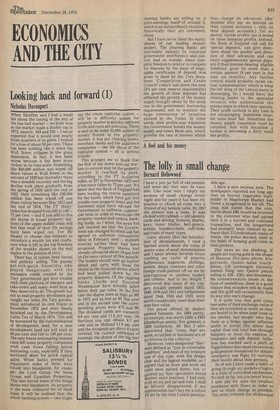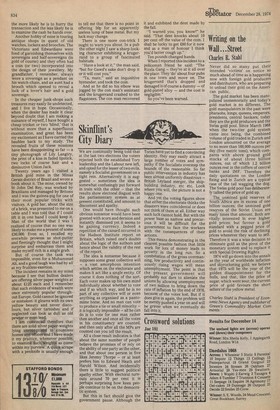A fool and his money
The lolly in small change
Bernard Hollowood
I have a jam jar full of old pennies and some day they may be valuable. Like most men I empty my pockets of small change every night and for years it has been my practice to chuck all coins into a drawer of my bedside table. By 1967 the cleawer was a, mess. It was choked with rubbish — old identity cards and driving licences, diaries, keys, razor blades, ball-points, stamps, handkerchiefs, cuff-links and coins of many types.
Later, shortly after the introduction of ddcimalisation, I read a learned article about the value of scarce coins of small denomination and I spent several feverish hours combing my cache of pennies, halfpennies, sixpences, shillings, nickels, dimes, centimes and other foreign trash palmed off on me by unscrupulous or careless traders and cabbies. And to my delight 1 discovered that many of my coppers, notably pennies dated 1953, 1949, 1936 and 1911 and halfpennies dated 1944, 1924 and 1910, were worth considerably more than their then face value.
The prices offered by dealers seemed fantastic. An 1869 penny, for example, was worth £200; a 1953 Elizabethan penny, five guineas; a 1956 halfpenny, £9. But I also discovered that "coins that are worn, scratched or mutilated are of no interest to the collector."
However, coins designated "fine" were defined as "just in collectable condition" and most of my treasure was of this type, with the design clear and the legend readable, so 1 argued that as more and more old coins were melted down, lost or ignored my 'fine' specimens would become more precious. I had only to sit on my jam jar and wait. I shall be bitterly , disappointed if my numismatism can't buy me a colour p/ set by the time I reach pension
able age.
I have a new interest now. The newspapers reported not long ago that an honest vegetable stallholder in Megthorpe Market had found a krugerrand in his till. The chap had stated that the coin, worth about £90, would be returned to the customer who had parted with it in a hurried and confused transaction, 'and the krugerrand had promptly been claimed by no fewer than 213 individuals, many of whom, the police decided, were in the habit of keeping gold coins in their pockets.
This news set me thinking. If people are buying gold in the shape of Mexican fifty-peso pieces, krugerrands, Queen Anne touchpieces, UK sovereigns (recently minted 'King' and 'Queen' pieces selling at £26 £30), and innumerable commemorative issues in the form of medallions, there is a good chance that mistakes will be made and this gold will occasionally find its way into one's change.
It is quite true that gold coins lose some of their exchange value if they are scratched or worn, as they are bound to be when kept loose in the pocket, but people who buy them as a hedge against inflation prefer to accept this minor loss rather than risk total loss through burglary or incur the expense of insurance and safe deposit. Inflation has reached such a pitch of frightfulness that small investors in gold prepare themselves for instant emergency and flight by carrying their wealth about their persons.
So of late I have made a habit of going through my pockets o'nights in a state of controlled excitement. No luck so far, but you never know. I now pay for even the smallest purchases with fivers in order to win as much change as possible. The more irritated the shopkeeper the more likely he is to hurry the transaction and the less likely he is to examine the cash he hands over.
Another hobby of mine is touring antique shops in quest of old watches, lockets and brooches. The Victorians and Edwardians were fond of garnishing themselves with sovereigns and half-sovereigns (in gold of course) and they often had a coin (or two) incorporated into the design of their jewellery. My grandfather, I remember, always wore a sovereign as a pendant on his watch-chain, and an aunt had a brooch which opened to reveal a lock of a lover's hair and a gold sovereign.
In the cheaper junk-shops such treasures may easily lie undetected, and I live in hope. Occasionally, when the dealer has made it clear beyond doubt that I am making a nuisance of myself, I haye bought a cheap trinket or two 'blind,' that is without more than a superfluous examination, and great has been my excitement as I have carried the baubles back to my study. The revealed fruits of these missions have been disappointing so far — a tiny photograph of Lily Langtry, the print of a kiss in faded lipstick, two locks of coarse hair and a diminutive Union Jack.
Twenty years ago I visited a British gold mine in the Minas Gerais district of Brazil and wrote a book about it. The mine, owned by St John Del Rey, was worked by Brazilians and managed by Britons and I was the guinea-pig for one of their most popular tricks with visitors. A gold bar, about the size of a brick, was presented to me on a table and I was told that if I could lift it in one hand I could keep it. Man of the world that I was I realised of course that no one was likely to make me a present of some £30,000. Even so, I recalled my erstwhile prowess as shot-putter and fleetingly thought that I might surprise and embarrass them and make myself rich in a single grab.
But of course the task was impossible, even for a Muhammad Ali, and a good laugh was had by all • at my fruitless exertion. The incident remains in my mind because I see that bullion dealers are offering silver paper-weights at about £125 each and I remember that such evidences of wealth were once extremely popular throughout Europe. Gold cannot be ignored or mistaken: it gleams with its own yellow beauty and never discolours, but silver tarnishes and if neglected can look as dull as old pewter or even lead.
I 'am convinced' therefore that there are solid silver paper-weights lying =mil:D.1*W in countless homes aticiWficeAnd I have made it my practice, whenever possible, to examine kiciNeights as come' within my purview. A quick scrape. with a penknife is usually enough
to tell me that there is no point in offering 50p for an apparently useless lump of base metal. But my luck may change.
There is one more con-trick I ought to warn you about. In a pub the other night I saw a sharp-looking character exhibiting a krugerrand to a group of fascinated habitues.
"Have a look at it," the man said, "but for Gawd's sake don't drop it or it will cost you."
'Ta, mate," said an inquisitive bystander, and took the coin.
And as he did so his elbow was jogged by the con man's assistant and the krugerrand crashed to the flagstones. The con man recovered it and exhibited the dent made by the fall.
"I warned you, you know!" he said. "That dent knocks about 10 per cent off the value of the coin. I shall be lucky to get £80 for it now and as a man of honour I think you'd better cough up."
Ten pounds changed hands.
When I reported this incident to a policeman friend he said: "The Rizzla Gang — they're at it all over the place. They `do' about four pubs in one town and move on. The krugerrand that's dropped and damaged is of course a dummy — of gold-plated alloy — and the cost is negligible."
So you've been warned.















































 Previous page
Previous page